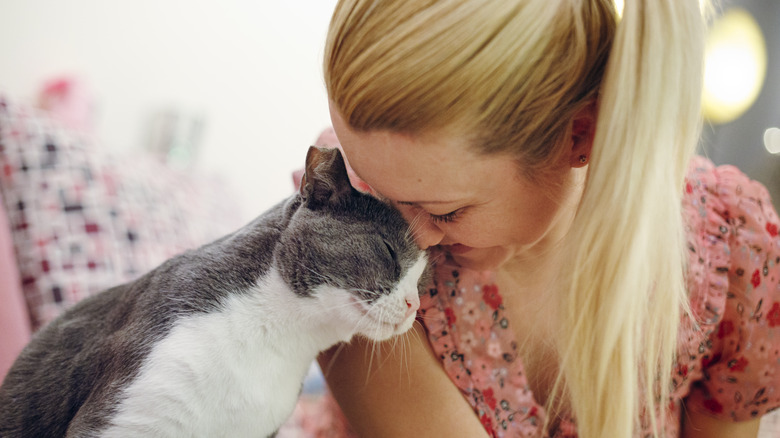Can You Contract Ringworm From Your Pets?
Pet lovers everywhere understand the comforting feeling of cuddling up to a furry friend. You may even feel euphoria when you hug your pet, which can be explained by the neurophysiological changes that occur during our interactions with them. Scientists have discovered that being around pets can improve our psychological well-being by increasing dopamine, serotonin, and oxytocin levels in the brain, according to Psych Central. It's believed that spending time with pets can decrease depression, anxiety, and stress, as they provide us with unconditional love and friendship.
However, despite the many benefits of cuddling with pets, a ringworm infection can make this activity more risky. If your pet has a ringworm infection, it is possible that you can catch it from your pet.
Ringworm isn't caused by worms, contrary to its misleading name. In moist and hot environments, naturally-occurring fungi multiply and trigger ringworm, which is a highly contagious skin infection, as explained by Cleveland Clinic. After coming into contact with the fungi, skin rashes can develop on different parts of the body, including the hands, feet, groin, thighs, and scalp. These rashes can usually be seen within four to 14 days of exposure. The name "ringworm" stems from the rash's characteristic circular appearance, notes Mayo Clinic. Certain lifestyle choices increase the likelihood of contracting ringworm, like playing high-contact sports or using public showers and locker rooms. Ringworm is more likely to impact individuals with compromised immune systems or autoimmune diseases.
Let's check out how ringworm spreads from pets to humans and what you can do to prevent you and your family from catching it.
How ringworm can spread from pets to humans
A fungus called Microsporum canis (M. canis) is linked to many transmissions of ringworm infection between dogs, cats, and humans, according to Pawlicy Advisor. Households with both dogs and cats are at an increased risk of spreading M. canis to one another. Although any human can contract the fungus from an infected dog or cat, elderly people, and children are more vulnerable due to their weaker immune systems.
The Centers for Disease Control and Prevention (CDC) explains that ringworm can be contracted by touching the fur or skin of an animal that's been infected. Surfaces exposed to ringworm, like blankets and toys, can carry ringworm for months and also initiate the spread, as pointed out by Cleveland Clinic.
Some dogs and cats are more susceptible to contracting ringworm and passing it along to their humans. Certain breeds of dogs, including Yorkshire terriers, Boston terriers, and Jack Russells, are more vulnerable to infection. In addition, cat breeds like Persians, Himalayans, and Rex can also be more prone to catching ringworm, as described by the Morris Animal Foundation.
Along with dogs and cats, humans can contract ringworm from other animals, like cows, horses, and goats. Another form of ringworm, called Trichophyton mentagrophtyes (T. mentagrophtyes), can infect pocket pets like guinea pigs and hamsters before passing to their owners.
Despite its contagious nature, there are ways to prevent ringworm from spreading within your family.
How to recognize ringworm and stop it from spreading
Knowing what ringworm looks like in pets is the first step to preventing it from spreading in your home. As explained by PetMD, circular bald patches with inflamed or cracked skin are some signs a dog may have ringworm. PetMD notes that infected cats experience similar hair loss, as the fungi invade the hair shaft and make their hair brittle. Both dogs and cats can experience ringworm infection in their nails, sometimes leading to nails that are irregular in shape.
Many symptoms of ringworm are similar in dogs and cats, but there are some notable differences. Dogs usually experience ringworm on their faces, ears, tails, and feet, while cats typically develop it on their heads, chest, front legs, and spine. It can be difficult to detect ringworm in some longhaired breeds of cats known as "asymptomatic carriers." This term means they are highly contagious but show no visible symptoms.
If you do notice anything unusual about your furry friend, it's important to have them examined by your veterinarian as soon as possible. To prevent the spread of ringworm, the CDC recommends disinfecting and vacuuming areas of your home where your pet has touched surfaces and objects. You should also use gloves and wear long sleeves when handling a pet suspected to have ringworm, and thoroughly wash your hands afterward. If you have a compromised immune system, you shouldn't touch any animal with ringworm.



